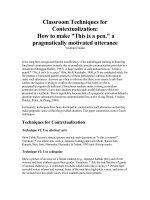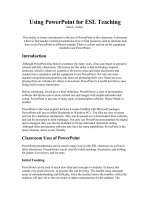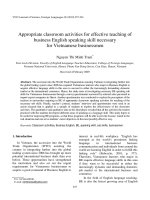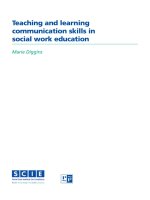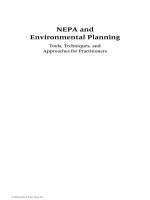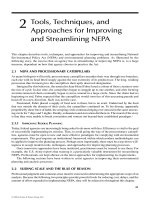dyslexia and inclusion classroom approaches for assessment, teaching and learning
Bạn đang xem bản rút gọn của tài liệu. Xem và tải ngay bản đầy đủ của tài liệu tại đây (957.79 KB, 114 trang )
TeAM
YYeP
G
Digitally signed by TeAM
YYePG
DN: cn=TeAM YYePG,
c=US, o=TeAM YYePG,
ou=TeAM YYePG,
email=
Reason: I attest to the
accuracy and integrity of
this document
Date: 2005.05.08
04:52:15 +08'00'
Classroom Approaches
for Assessment, Teaching
and Learning
Dyslexia
and
Inclusion
Gavin Reid
David Fulton Publishers Ltd
The Chiswick Centre, 414 Chiswick High Road, London W4 5TF
www.fultonpublishers.co.uk
First published in Great Britain by David Fulton Publishers in association with the
National Association for Special Educational Needs (NASEN)
10 9 8 7 6 5 4 3 2 1
NASEN is a registered charity no. 1007023.
David Fulton Publishers is a division of Granada Learning Limited, part of ITV plc.
Copyright © 2005 Gavin Reid
Note: The right of Gavin Reid to be identified as the author of this work has been
asserted by him in accordance with the Copyright, Designs and Patents Act 1988.
British Library Cataloguing in Publication Data
A catalogue record for this book is available from the British Library.
ISBN: 1 84312 361 4
All rights reserved. No part of this publication may be reproduced, stored in a
retrieval system or transmitted, in any form or by any means, electronic, mechanical,
photocopying, or otherwise, without the prior permission of the publishers.
Designed and typeset by Kenneth Burnley,Wirral, Cheshire
Printed and bound in Great Britain
Preface v
1 Understanding and Identifying Dyslexia 1
Definitions 1
Confusion and consensus 2
Policy and reports 2
Dyslexia research 3
Professional involvement and perspectives 3
Hidden disability 4
Programmes and resources 4
Characteristics of dyslexia 5
The role of the label 7
Dyslexia as a difference 8
Identification 8
Information processing 11
Assessment 11
Checklists 21
Discrepancies 22
Differences 23
Formative and summative assessment 27
Dynamic assessment 27
Information from text 27
Summary 28
2 Teaching Approaches and Learning Strategies 30
Processes of learning 31
Information processing 32
Teaching – principles 33
Programmes and strategies 36
Language experience 37
Creative writing 39
Teacher modelling 41
Self-questioning 42
Critical literacy 43
Other support approaches 44
Assisted learning 46
Chapter 1
Contents
Engaging parents 47
Learning strategies 48
Role-play to foster understanding 49
Transfer of skills 49
Assessing metacognitive awareness 50
Paired thinking 51
Multiple intelligences 52
Study skills 54
Comment 58
3 Curriculum Perspectives and Planning for Learning 60
Interventions and dyslexia 60
Planning for learning in the primary school 64
Identification of learning style 68
Knowledge of information processing 69
Planning for learning in the secondary school 71
Differentiation 77
Key issues 78
Other considerations 80
Awareness raising 83
Summary 83
4 Dyslexia and Inclusion 85
Inclusion 85
Inclusion – meeting needs 86
Principles and practices of inclusion 87
Five signposts to inclusion 89
Key factors 94
Comment 94
Conclusion 95
Further Information and Contacts 99
References 101
Contents
iv
The purpose of this book is to provide the class teacher with an under-
standing of dyslexia and to offer some specific and practical approaches
for assessment, teaching and learning.The book aims to highlight how
the needs of children with dyslexia can be met within the curriculum
and within the mainstream classroom. The key theme of the book
suggests that intervention for dyslexic children should focus on the
barriers to learning, and the most prominent of these may be aspects of
the curriculum and how the curriculum is presented. That is not to say
that identifying cognitive difficulties are not important. They are, as
these can help to inform the teacher of the potential difficulties that can
be experienced by children with dyslexia. But it is crucial that the
literacy and cognitive difficulties usually associated with dyslexia should
not dictate classroom approaches, or curriculum content.The key is to
be pro-active and to anticipate the type of difficulties that can be
experienced, and to ensure that through carefully prepared IEPs
(individual education plans), insightful use of resources and, above all,
through differentiation and learning styles, that the curriculum can be
accessed by all dyslexic children.
In order for this to be effective teachers need to have an under-
standing of dyslexia and to be aware of criteria that can be used for
identification and assessment. This is, therefore, covered in Chapter 1 of
this book. Class teachers, it is suggested here, have the responsibility for
identifying and ensuring that the needs of dyslexic children are met.
But it is important to recognise that this is a shared responsibility and
that this has implications for the role of the school management and
collaboration with other professionals, other teachers and with parents.
Staff development, therefore, is crucial and should provide all teachers
and school management with an awareness of dyslexia.
Policy on dyslexia is also important and there are already some
good examples of comprehensive policies on dyslexia at education
authority and school level. Policies need to be comprehensive as they
need to incorporate the training requirements, as well as the role of
classroom teachers, in identification, assessment and curriculum
planning in relation to identifying the barriers that can be faced by
dyslexic children and how these barriers can be overcome.
v
Chapter 1
Preface
The other key theme of the book is that of inclusion – this implies
that the needs of all children with dyslexia should be met within
mainstream school. It is, however, recognised in this book, particularly
in Chapter 4, that inclusion can incorporate alternative networks of
support that can cater for the needs of dyslexic children at certain
points in their education.
It is important to recognise that while there are many trained
dyslexia specialists and specialised dyslexia resources available, policies
relating to the National Literacy Strategy and inclusion suggest that
classroom teachers now have the key role to play in identification and
planning for the learning of dyslexic children. Ideally this should be a
shared responsibility but nevertheless this does place considerable onus
on the class teacher to develop and present the curriculum in a
dyslexia-friendly way.
This book discusses inclusion and curriculum planning and
essentially aims to equip the class teacher with the knowledge and the
confidence to deal with dyslexia within the curriculum, and in an
inclusive educational setting.
Preface
vi
Dyslexia is a term that is frequently used in schools and in the wider
community – yet a term that many would admit is surrounded by
confusion and ambiguity. Such confusion does not help the teacher
understand the needs of children with dyslexia and this can in fact give
rise to some anxiety. It is the aim of this book to clarify the confusion
surrounding dyslexia from the class teachers’ perspective and to
highlight some strategies for identification and teaching and particularly
to provide a curriculum perspective in order to ensure that learners will
have access to the full curriculum.
Definitions
One of the areas of confusion centres on issues relating to definitions of
dyslexia. There is a range of definitions that are currently used to
describe dyslexia. This can cause confusion particularly in relation to the
identification of dyslexia, as the use of the label ‘dyslexia’ may depend
on the specific identification criteria applied. Burden (2002) suggests
that dyslexia is a ‘convenience term’ because it can embrace a number
of different types of difficulties and, therefore, the term ‘dyslexia’ in
itself is not helpful. While there is some validity in this – mainly because
of the overlapping features between dyslexia and other types of difficul-
ties – it is evading the issue to describe dyslexia as a convenience term.
There are some core characteristics of dyslexia that are important for
identification and assessment and for the development of IEPs, teaching
and curriculum materials. These characteristics – whatever the term
used to describe them – can present considerable barriers to learning for
children and young people in school. It may be helpful to view dyslexia
from the perspective of attempting to identify and address the barriers
to literacy and learning that can be experienced by the child.These
barriers will be described throughout this book, but it is important to
acknowledge that the means of addressing these barriers can lie within
the classroom environment and curriculum differentiation as much as
with the use of any specialised resources.
1
Chapter 1
Understanding and Identifying
Dyslexia
Confusion and consensus
The confusion that surrounds the use of the term ‘dyslexia’ has arisen
for a number of reasons. As far back as 1978 the Warnock Report (DES,
1978) acknowledged the presence of children who had unexpected and
unusual difficulties in literacy, but stated that the term ‘dyslexia’ was not
helpful to describe these children and that the term ‘specific learning
difficulties’ would be a more appropriate one to use. Education
authorities, therefore, were reluctant to use the term ‘dyslexia’ and this
was not helpful in the quest to clarify the term, nor to give teachers an
understanding of dyslexia and to examine the implications of this for the
classroom. The reluctance to use the term also gave rise to a vigorous
(and largely successful) lobbying campaign by a range of pressure
groups to have the term accepted and applied.
Policy and reports
An indication of how this situation has changed since the 1980s can be
seen in recent government and education authority policy documents
that have mentioned and, indeed in some cases, focused on policy,
specifically for dyslexia. Both the Irish Republic (Task Report on
Dyslexia 2001) and Northern Ireland Government (Task Group Report
on Dyslexia 2002) have published extensive policy documents on
dyslexia. Indeed, in the preface to the Northern Ireland task group
report the Minister for Education indicated that the report highlighted a
very real concern that provided challenges for all in education. This
concern, he suggested, surrounds:
particularly the need for training for classroom teachers in
recognising where children have, or may have, dyslexia and in
putting in place the means to address their difficulties.
Similarly, in England and Wales there have been vigorous dyslexia-
friendly schools’ campaigns that have been supported by the
government in collaboration with the British Dyslexia Association.
This has resulted in materials being widely circulated to schools and
significant efforts to provide an education authority-wide attempt to
identify and tackle dyslexia. Scotland has also witnessed collaboration
between education authorities, the Scottish Executive, teacher education
institutions and voluntary associations to develop teaching programmes,
and resources for identification and intervention for dyslexia (Reid,
2001; Crombie, 2002).
Dyslexia and Inclusion
2
Dyslexia research
As well as confusion stemming from the initial reluctance to use the
term dyslexia, following the Warnock Report, the confusion has also
occurred because the research field in dyslexia is a multi-faceted one,
that can be characterised as much by disagreement as agreement.
In short, there are research activities in different aspects of neurology
brain structure, neurological processing, the cerebellum, visual cortex,
as well as speech and language processing. Additionally, cognitive
psychologists are involved in studies involving memory and dyslexia as
well as the role of processing speed and the cognitive routes to literacy
acquisition. This can present a confusing picture for teachers who are
seeking straight-forward explanations of dyslexia and guidance for
practice. The picture can be further confused by the range of alternative
interventions (and often costly) programmes that have been developed
for dyslexia (Reid, 2003). Silver (2001) comments that alternative
programmes and controversial therapies develop too quickly, and the
time from initial conception to acceptance of a particular idea is usually
not long enough. This should take years and needs to be supported by
research published in peer-reviewed journals. He suggests that there is
too much anecdotal evidence that often convinces parents of the value
of certain approaches, and it should be acknowledged that what works
for one child may not be successful for another. The effect of research
activities in neurological areas and the commercial thrust of alternative
therapies have often resulted in teacher conferences on dyslexia
being dominated by this type of information. It is crucial, therefore,
that the focus for intervention should be firmly based in classroom
practices.
Professional involvement and perspectives
The diversity in research in dyslexia has resulted in many professional
and other groups being involved in suggestions for intervention. This
can be confusing to both parents and teachers. For example, the
following can each have some input into a case conference on a child
with dyslexia:
•
class teacher
•
educational adviser for the education authority
•
SENCO/ learning support
•
educational psychologist
•
clinical psychologist
•
occupational therapist
•
ICT specialist
3
Understanding and Identifying Dyslexia
•
optometrist
•
parents
The different research perspectives that can account for some of the
confusion can be seen in the British Psychological Society (BPS)
working party report into assessment of dyslexia (BPS, 1999). The
report offers ten different hypotheses to explain and understand
dyslexia. Some of these relate to cognitive aspects such as how children
process information, some to reading characteristics such as phonologi-
cal awareness and visual processing difficulties, and others to learning
opportunities and environmental factors. This can provide some
indication of the broad scope of dyslexia.
Hidden disability
There is now some agreement that dyslexia represents more than a
reading difficulty.
While there are many well-enunciated principles for teaching
children with dyslexia, a closer examination of these indicate that many
of these principles incorporate good teaching practices which will in fact
benefit all children.
Dyslexia can be described as a hidden disability because we may not
know the person has dyslexia until they are put into a situation that
requires skills in literacy or processing certain types of information. At
school many children become skilled at covering up and compensating
for their dyslexic difficulties, usually by avoiding reading aloud or
writing as little as possible. Sometimes dyslexia can be misunderstood
for laziness or lack of interest in school work. In reality that is far from
the case – usually children with dyslexia extend more effort than others
because of their difficulty, and may often become tired very easily as a
result of this effort.
Programmes and resources
It is important therefore to ensure that class teachers have an under-
standing of dyslexia and of the strategies and supports that are
appropriate and can be readily applied to the classroom without
referring to costly commercially produced materials.
There is of course a wide range of programmes and resources which
have been specifically developed for use for children with dyslexia, many
of these are excellent and will be referred to in the following chapter of
this book.
Dyslexia and Inclusion
4
Characteristics of dyslexia
Hearing
The above diagram refers to the different aspects that are influential in
an understanding of dyslexia. The ear represents the auditory aspects.
These can be important in relation to developing phonological
awareness. Phonological awareness is seen as being a crucial factor in
dyslexia – that is, differentiating between sounds, especially sounds that
are similar, remembering these sounds and identifying them in words.
These aspects can present difficulties for dyslexic children.
Sight
The eye symbol in the above diagram represents the visual aspects of
dyslexia. Some dyslexic children may have some visual disturbance
when reading print and this can cause blurring, words merging and
omissions of words or lines when reading. Coloured overlays for some
children have been successful, as has the use of coloured background for
text and the font characteristics and font size.
5
Understanding and Identifying Dyslexia
DYSLEXIA
Connections
The symbol in the diagram above between the eye and the ear
represents the neurological basis for dyslexia and the importance of
neurological connections. These connections help with the integration
of different skills such as visual/motor integration, as in copying, and
auditory/kinaesthetic integration, as in listening and carrying out
instructions. There is considerable research evidence that highlights the
neurological basis of dyslexia and in particular the connecting pathways
of the left and right hemispheres as well as aspects relating to the
cerebellum and the magnocellular visual system. These factors affect
processing speed as well as visual accuracy and co-ordination.
Motor skills
The symbol of the child on the bicycle represents the motor aspects of
dyslexia. The cerebellum in particular has been implicated in this, and
a number of dyslexic children will display fine motor and gross motor
difficulties that can result in poor handwriting and/or clumsiness.
The core difficulties
The pencils and the book in the above diagram represent the core diffi-
culties associated with dyslexia – reading, spelling and writing. These
tasks are usually left hemisphere skills, apart from creative writing,
which can be associated with the right hemisphere. The research
indicates that dyslexic children have weaknesses in the left hemisphere
so therefore tasks involving phonics, accuracy, sequencing and
remembering will be more challenging and often more exhausting for
the child with dyslexia.
Interaction
The last three symbols in the diagram above show a teacher with a
student, the school building and a bowl of fruit. The teacher and the
student highlight the importance of interaction. Quite often children
with dyslexia need interaction with the teacher in order to provide the
most appropriate cues, structure and to help develop connections with
previous learning.This aspect cannot be emphasised strongly enough
because if interaction does not take place, for example through
teacher/pupil question and answer, then the dyslexic person may fail to
grasp the underlying concepts and the information will be less
meaningful. This interaction can lead to what is sometimes referred to
as metacognition. This involves the student questioning him/herself as to
why he/she thinks in a certain way. This type of self-questioning is an
aspect of metacognition. This is dealt with in more detail in subsequent
chapters of this book.
Dyslexia and Inclusion
6
School ethos
The symbol of the school highlights the importance of the school ethos
and the learning environment. It is important that the child feels
comfortable in the school particularly since for many dyslexic children
school represents a place of failure. It is crucial that this view is reversed
and a welcoming and positive school environment can help greatly with
this.
Diet
The bowl of fruit represents the role of diet in learning. Dyslexic
children and indeed all children require a well-balanced diet to learn
effectively. Research by Richardson (2002) highlights the importance of
essential fatty acids to maximise efficient learning and that many
children with dyslexia are deficient in Omega 3 and Omega 6 essential
fatty acids.
The whole diagram seeks to highlight the breadth of the areas
involved in dyslexia – it is not a narrow syndrome, but one that incorpo-
rates many aspects of language and of learning.
The role of the label
Usually the term ‘dyslexia’ is only applied after a fairly extensive
assessment process as it is important that labels are not used
unnecessarily. A label generally brings a set of expectations. These can
relate to a more informed selection of resources, or a different set of
expectations from parents, and perhaps teachers. While a label can be
helpful, it can also be disadvantageous and may lead to a resignation
that dyslexia can only be dealt with by ‘experts’. This is a misguided
assumption, and may lead the teacher to feel she/he possesses neither
the skills, nor the training, to deal with dyslexia in the classroom.Yet
there is, in fact, no specific approach that is universally recognised to
deal with dyslexia. The notion of multi-sensory approaches involving the
use of visual, auditory, kinaesthetic and tactile strategies are believed to
be essential for children with dyslexia, yet such approaches are also
useful for all children and indeed incorporate elements of good
teaching. There are, however, many specific teaching programmes often
used with children with dyslexia that are built around these approaches,
as well as an enhanced understanding of the type of difficulties
experienced by children with dyslexia.
The key point, therefore, in teaching children with dyslexia is
knowledge of teaching, not access to resources. It is important that the
teacher has knowledge and understanding of the type of difficulties
associated with dyslexia and also of the actual child, i.e. his/her profile,
background, difficulties, strengths and the strategies that have already
7
Understanding and Identifying Dyslexia
been utilised. This is extremely important as the profile of strengths and
difficulties presented by children with dyslexia can differ. This,
therefore, means that the responsibility for teaching children with
dyslexia lies, not with a ‘specialist’, but with class teachers who have the
knowledge and the experience of adapting and differentiating teaching
materials, and are able to adapt their teaching to suit the needs of the
learner. Aspects relating to curriculum development are also crucial and
the needs of children with dyslexia can be met, as much through careful
planning of curriculum and teaching objectives, as through the use of
specialised materials.
Dyslexia as a difference
Dyslexia can be described as a difference in the way some people
process information. This means that reading accurately, and at speed,
can be difficult for children with dyslexia, as can spelling accurately and
writing in a structured manner. The individual with dyslexia can become
confused when several instructions are given at the same time, and will
usually have a poor short-term memory, difficulty with directional
orientation, such as telling right from left and map reading.They may
also have a word finding difficulty and in discussions and conversation
may use inappropriate words – perhaps words that sound or look similar
– such as ‘were’ and ‘where’ and ‘there’ and ‘their’. They may also
confuse syllables in words, or put these in the wrong order when writing
or talking, such as ‘preliminary’ or ‘elephant.’ But essentially the charac-
teristics can amount to a different way of processing information – they
usually have a visual, right-brained global processing style and it is
important to acknowledge the strengths in this style, as well as
considering the difficulties.
Identification
When identifying dyslexia it is preferable to have both a rationale and a
strategy for the assessment. Often a suspicion of the presence of dyslexic
difficulties can be identified through observation, or through the results
of routine assessments. This information, however, needs to be contextu-
alised, so that an overall picture of the child’s profile can be seen and
evidence of dyslexia, if any, can be noted, and importantly the barriers
to learning identified.This is necessary, as one of the purposes of identi-
fication of dyslexia is to identify the most appropriate teaching and
learning approaches. Some general aspects relating to the purpose of an
assessment include the following:
Dyslexia and Inclusion
8
•
identification of the learner’s general strengths and weaknesses;
•
indication of the learner’s current level of performance in
attainments;
•
an explanation for the learner’s lack of progress;
•
identification of aspects of the learner’s performance in reading,
writing and spelling, which may typify a ‘pattern of errors’;
•
identification of specific areas of competence;
•
understanding of the student’s learning style;
•
indication of aspects of the curriculum that may interest and
motivate the learner; and
•
specific aspects of the curriculum that are challenging for the child.
Some of the specific characteristics that can be noted include the
following:
Reading
•
difficulty in recognising sounds in words;
•
difficulty in remembering the combinations of letters that make up
sounds such as ‘ph’ and ‘th’ and remembering these and using them
in a word;
•
sequencing the sounds and the letters in words in the correct order;
•
substitution of words when reading aloud, for example saying ‘car’
for ‘bus’;
•
difficulty with rhyming, remembering, for example nursery rhymes
and remembering the sequence of the rhyme;
•
may find it difficult to sound out sounds in words;
•
reverses, omits or adds letters;
•
loses the place when reading;
•
may have difficulty with the sequence of the alphabet;
•
difficulty pronouncing multi-syllabic words, even common ones;
•
poor word attack skills – particularly with unknown words;
•
reading speed tends to be slow and hesitant and often with little
expression;
•
reluctance to read for pleasure;
•
reading comprehension tends to be better than single word reading;
and
•
confuses words which have the same or similar sounds – such as
‘their’ and ‘there’ and ‘access’ and ‘assess’.
Spelling
•
difficulty remembering spelling rules;
•
making phonological errors in spelling, for example ‘f’ for ‘ph’;
•
letters out of sequence;
•
inconsistent use of some letters with similar sounds such as ‘s’ and
‘z’;
9
Understanding and Identifying Dyslexia
•
difficulty with word endings, for example using ‘ie’ for ‘y’;
•
confusion or omission of vowels; and
•
difficulty with words with double consonants such as ‘commission’.
Writing
•
inconsistent writing style;
•
slow writing speed;
•
inconsistent use of capital and small letters;
•
reluctance to write any lengthy piece; and
•
a sometimes unusual writing grip or sitting position.
Memory
•
poor short-term memory which means probable difficulty
remembering lists; and
•
may also show signs of poor long-term memory which could be due
to confusion at the time of learning or poor organisational strategies.
Organisation
•
poor organisational strategies for learning; and
•
poor organisation of timetable, materials, equipment and items
needed for learning, such as remembering and organising homework
notebook.
Movement
•
may have difficulty with co-ordination and tasks such as tying
shoelaces; and
•
bumping into furniture in the classroom, tripping and frequently
falling.
Speech development
•
confusing similar sounds;
•
poor articulation;
•
difficulty blending sounds into words;
•
poor awareness of rhyme;
•
poor syntactic structure; and
•
naming difficulties.
It is important to recognise that many of these factors above can be seen
in a continuum of difficulties from mild to severe, and the extent and
severity of these difficulties will have an impact on the assessment
results and the subsequent recommendations for support.
Dyslexia and Inclusion
10
Information processing
It can be suggested that dyslexia is an information processing difficulty.
Information processing describes the interaction between the learner
and the task. Essentially the information processing cycle has three main
components. These are:
•
Input – auditory, visual, tactile, kinaesthetic
•
Cognition – memory, understanding, organising and making sense
of information
•
Output – reading aloud, talking, discussing, drawing, seeing, experi-
encing
Children with dyslexia can have difficulty at all three stages of this cycle.
It is important, therefore, to draw on diagnostic data that involves these
three stages. It can be useful to acknowledge this when identifying the
difficulties experienced by the child. For example one can ask whether
the same difficulties are experienced if the material is presented visually
as opposed to auditorily. Perhaps the individual can learn more
effectively if he/she is able to experience the actual learning through the
kinaesthetic modality. Although this is related to teaching approaches it
is crucial that this is acknowledged in the identification and assessment
process as it is important that reasons for the difficulty are sought, and
further, that a clear link can be forged between assessment and teaching
approaches.
Assessment
Process and strategies
Dyslexia should not only be identified through the use of a test.
Assessment for dyslexia is a process and that process involves much
more than the administration of a test. The assessment needs to
consider classroom and curriculum factors, as well as the specific diffi-
culties and strengths shown by the child.
Specifically, assessment should consider three aspects – difficulties,
discrepancies and differences, and these should relate to the classroom
environment and the curriculum.
The central difficulty is usually related to the decoding, or the
encoding, of print and this may be the result of different contributory
factors. For example, some difficulties may include phonological
processing, memory problems, organisational and sequencing difficul-
ties, movement and co-ordination, language problems, or visual-
perceptual/auditory-perceptual difficulties.
The discrepancies may be apparent in comparing decoding and
reading/listening comprehension, between oral and written responses
11
Understanding and Identifying Dyslexia
and in performances within the different subject areas of the
curriculum.
It is also important to acknowledge the differences between
individual children with dyslexia. The identification process should,
therefore, also consider learning styles and cognitive styles. An apprecia-
tion of this can help to effectively link assessment and teaching.
Miscue analysis during oral reading
The strategy known as miscue analysis is based on the ‘top-down’
approach to reading that was developed from the work of Goodman
(1976). Goodman argued that the reader first has to make predictions
as to the most likely meaning of the text. Such predictions were based
on how the reader perceived the graphic, syntactic and semantic
information contained in the text.
Goodman suggested that by using miscue analysis a teacher can
listen to a child read and determine whether a mistake or ‘miscue’
results. These miscues can arise from symbolic, syntactic or semantic
errors. Symbolic errors would mean that the child has misread the
actual letter(s) and this can be a result of a visual difficulty. Syntactic
errors may occur when the child reads the word ‘of’ instead of ‘for’. This
would indicate that the child does not have the grammatical structures
of sentences but can make a fairly good stab at the symbolic features of
the word – even though it is still wrong. The other type of errors –
semantic errors – are quite common in children with dyslexia as these
kinds of errors would indicate the reader is relying heavily on context.
An example of a semantic error would be reading the word ‘bus’ instead
of ‘car’.
An example of how miscue analysis can be used in a passage is
shown on the following page.
Goodman used the phrase ‘psycholinguistic guessing game’ to
describe how readers, especially poor readers, tackled print.This means
that children used contextual and symbolic cues to read rather than
decoding every word. If the child misread, this means they used the
wrong cues, or failed to understand the meaning of the text and,
therefore, could not use this to help them ‘guess’ the word.
This was a move away from the bottom-up model of reading that
had, up until this point, dominated literacy teaching. The bottom-up
model emphasises the decoding of individual letters and sounds by
breaking words into phonemes – the sound component of words – and
building up words and sentences from this. This implies the child needs
to read accurately before any meaning can be extracted from the text.
Goodman’s view on the other hand suggested that even poor readers
can extract meaning from text by using contextual and other cues. The
essence of the top-down approach was that the reader started with the
whole and moved to the ‘parts’.
Dyslexia and Inclusion
12
13
Understanding and Identifying Dyslexia
(reproduced from Arnold, 1984, with permission from Hodder & Stoughton)
Goodman’s theory gave impetus to the ‘whole book approach’ and in
fact fuelled what is known as the ‘literacy wars’. This term describes the
controversy over top-down approaches (meaning and language
experiences) and bottom-up (decoding and phoneme) approaches to
teaching reading. The important point for our purposes here is that
Goodman’s approaches also gave impetus to a more diagnostic approach
to the assessment of reading. This approach was further emphasised by
Marie Clay with the Reading Recovery Programme (Clay, 1979) which
also used miscue analysis as one of the fundamental approaches to
diagnosing a child’s reading level.
One of the important aspects about miscue analysis is that it can
help the teacher make deductions about the reader’s understanding of
the text. For example, if the child read ‘the poor horse bolted his food’
instead of ‘the scared horse bolted fast’ this would indicate that he/she
has little real understanding of the text apart from the fact it concerns a
horse. This would likely indicate a difficulty with the semantics of the
text, since the guess does not properly fit the context. The syntactic flow
of the sentence appears to be correct and there is some attempt to
represent the symbols.
Miscues, therefore, can inform the teacher about how the reader
perceives the text and the pattern of errors that may exist. It is also
important to observe whether the miscue is self-corrected, the graphic
or phonemic similarity between the expected response and the observed
response (what the child actually says) and whether the miscue
produces syntactically or semantically acceptable text.
It is, therefore, possible to obtain useful data on the child’s reading
pattern by observing the reading errors and noting the significance of
these oral errors.
The type of errors often noted in miscue analysis and the signifi-
cance of these are shown below:
Omissions
These may occur if the child is reading for meaning rather than the
actual print. He/she may omit small words that do not add anything
significant to the meaning of the passage.
Additions
These may reflect superficial reading with perhaps an over-dependence
on context clues.
Substitutions
These can be visual or semantic substitutions and they may reflect an
over-dependence on context clues.
Dyslexia and Inclusion
14
Repetitions
These may indicate poor directional attack, especially if the child reads
the same line again. These may also indicate some hesitancy on the part
of the child perhaps being unable to read the next word in the line.
Reversals
These may reflect the lack of left–right orientation. Reversals may also
indicate some visual difficulty and perhaps a lack of reading for meaning.
Hesitations
These can occur when the reader is unsure of the text and perhaps
lacking in confidence in reading. For the same reason that repetitions
may occur, the reader may also be anticipating a difficult word later in
the sentence.
Self-corrections
These would occur when the reader becomes more aware of meaning
and less dependent on simple word recognition. It is important to
recognise the extent of self-corrections as this can indicate that the child
does have an understanding of the passage. Children with dyslexia can
show most of the miscues noted above, especially as often they read for
meaning and, therefore, additions and substitutions can be quite
common.
Phonological assessment
To a great extent this can be carried out by the teacher from teacher-
adapted materials or indeed through observation of the child’s reading
pattern. Gorrie and Parkinson (1995) have provided a structured set of
phonological assessment procedures and an example of the score sheet
showing the types of aspects assessed is shown on the following page.
The procedures developed by Gorrie and Parkinson consist of an
assessment and a linked programme. The programme contains three
components – assessment, games and resources. The assessment section,
as can be noted above, provides a very detailed analysis of the child’s
phonological awareness and covers the following areas:
•
polysyllabic word/non word repetition and recognition;
•
syllable segmentation, deletion of prefixes and suffixes and deletion
of syllables;
•
intra-syllable segmentation such as detection of onset and rime at
rhyme judgement and production; and
•
phoneme segmentation such as blending, detection and deletion of
initial and final phonemes.
15
Understanding and Identifying Dyslexia
Dyslexia and Inclusion
16
Assessment Page Raw score % Comment
Polysyllabic Word/Non-word
1.1 Repetition – Word
– Non-word
1.2 Recognition
Syllable Segmentation
2.1 Detection of Syllables
2.2 Counting Syllables
2.3 Production of Syllables
2.4 Compound Word
2.5 Deletion of Prefixes & Suffixes
2.6 Deletion of Syllables
Intra-Syllable Segmentation
3.1 Detection of Onset
3.2 Detection of Rime
3.3 Deletion of Onset
3.4 Production of Onset
3.5 Judgement of Rhyme
3.6 Production of Rhyme
Phoneme Segmentation
4.1 Blending
4.2 Detection (clapping)
4.3 Detection (saying sounds)
4.4 Deletion of Initial Phonemes
4.5 Deletion of Final Phonemes
Recommendations
Name ______________________________________ Date ___________________ CA _______________
(reproduced from Gorrie and Parkinson, 1995, with permission from Stass Publications)
Phonological awareness procedure – score sheet
These aspects can be readily observed by the teacher and an
appropriate programme developed from these observations. This of
course will mean focusing on the bottom-up aspects of reading.Yet
whatever view or perspective one adopts in relation to models of
reading, it is crucial and fairly widely accepted that all children need a
basic grasp of literacy structures before they can benefit from contextual
top-down reading strategies.
There are also standardised phonological assessments available and
recommended for use in an assessment for dyslexia. One such
assessment is detailed below:
The Phonological Assessment Battery (PhAB)
The battery consists of five measures:
•
Alliteration test
•
Rhyme test
•
Naming speed test
•
Fluency test
•
Spoonerism test
This test may to be very suitable to use to assess dyslexic difficulties.
There is good evidence that dyslexic children have difficulty with rhyme
and alliteration and some researchers have indicated that naming speed
is in itself a significant feature of dyslexic difficulties (Wolf and O’Brien,
2000; Nicolson and Fawcett, 2001).
The Phonological Assessment Battery (Frederickson et al 1997)
can be accessed by all teachers and is available from NFER-Nelson,
www.nfer-nelson.co.uk.
Screening/baseline assessment
There are some issues that can be raised in relation to screening and
baseline assessment. These include:
•
What is the most desirable age (or ages) for children to be screened?
•
Which skills, abilities and attainments in performances should
children be screened for?
•
How should the results of any screening procedures be used?
It is important that the results of screening and baseline assessments are
used diagnostically and not to prematurely label children. There are
some screening tests that have been developed specifically to identify the
possibility of dyslexia. These can yield very useful information but
should be used in conjunction with other data obtained from observa-
tions made by the teacher of the child’s work and progress in class, and
in different areas of the curriculum. These include the following:
17
Understanding and Identifying Dyslexia
